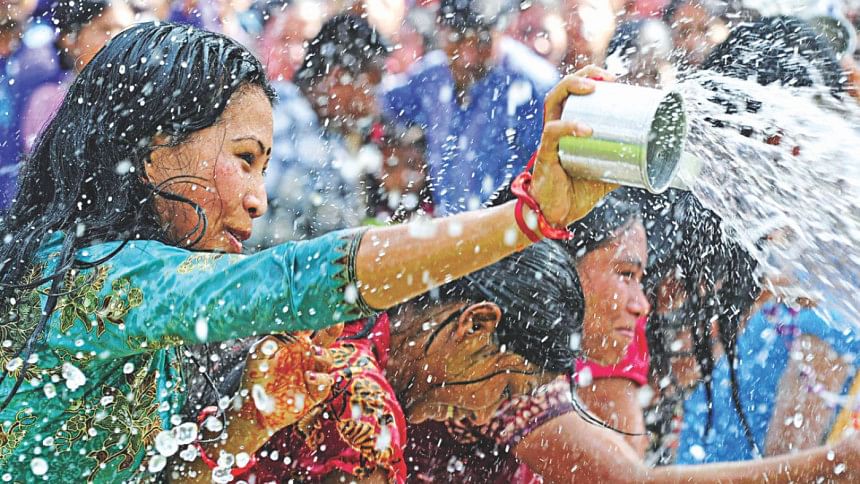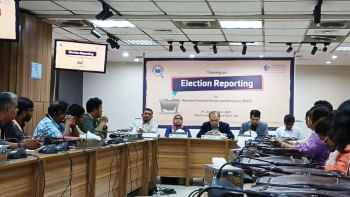The many shades of Boisabi

Pahela Baishakh is perhaps the sole festival that comes in every Bengali's life with a call to link the past with the present and welcome the New Year with rapturous rhythms of rejuvenation, vibrant colours and new hope. The time-honoured Bengali spirit of festivity and frolic is renewed again to hail the Bangla New Year 1424.
Today is Pahela Baishakh and people irrespective of religion and race are all set to celebrate the country's largest secular festivity.
Every Baishakh, the first month of the Bangla calendar, people wish to shake off the previous year's gloom and prepare to usher in the New Year with renewed vigour. Baishakh brings with it a whole new flurry of festivities and celebrations.
Bangla Noboborsho is an ancient tradition of this country. Through the festivals of Pahela Baishakh the people of this country have kept their tradition alive. Traditionally, Pahela Baishakh reminds us of ektara, dhak-dhol and shankhadhwani; the taste of panta-ilish; and the daylong funfair in traditional attire. The festival is, in no way, related to any religion. Baishakh beckons the non-communal or secular spirit of our culture. It is a festivity for all.
Baishakh is celebrated with a difference in the hilly districts of Chittagong, though the theme of a fresh beginning is similar in every corner of Bangladesh. Here in the tranquil green hills, “Boisabi” – as it is known – is significantly different from Chhayanaut's Borshoboron and Charukola's (Dhaka University Arts Faculty) Mongol Shobhajatra, a unique celebratory procession of hailing the Bangla New Year. The Mongol Shobhajatra was recently declared as an Intangible Cultural Heritage of Humanity by Intergovernmental Committee of UNESCO.
In the Chittagong Hill Tracts (CHT), the cultural co-existence and harmony in diversity is unique during Boisabi. Three predominant indigenous communities – Chakma, Marma and Tripura – celebrate the New Year in different ways and with different celebrations. The term “Boisabi” originates from Tripura's festival “Boisuk”, the Marma's “Sangrain” and the Chakma's “Biju”.
Boisabi features time-honoured religious-cultural rituals: cultural events, children's painting competitions, traditional sports like bolikhela (wrestling) and colourful processions. People of all ages, attired in traditional indigenous dresses, delve into celebrations adding different shades to the occasion.
The Chakmas set off the three-day Biju Utsab with “Phool Biju”, where young girls float flowers in water bodies on the penultimate morning of the outgoing year, seeking divine blessings. On the last day of the year, called “Mul Biju,” they prepare a vast range of delicacies and offer these to the villagers. Their mixed vegetable curry called “Pachan”, and traditional pithas, served with “Chuani” (locally brewed rice liquor) add to the celebrations.
The first day of the New Year called “Gojjya Pojjya Din” is the day to start anew and pray to Lord Buddha for yearlong peace and prosperity. Guests, irrespective of religion or ethnicity, are welcomed in people's homes.
The Marmas celebrate the Sangrain festival, welcoming the New Year. In the run up to the celebrations, they clean and decorate their houses, prepare traditional food and participate in rituals. Their biggest event is the water festival. People, mostly young boys and girls, participate in the festival splashing water on one other. The Marmas, along with tourists and Bengalis, gather at different points to take part in Sangrain.
Scorching heat is one of the unwelcoming aspects of the month of Baishakh. Yet, people pour onto the streets every year to usher in the festival. This is reflective of Bengalis' true love for their cultural roots and tradition. But, in CHT, Boisabi celebrations vary among indigenous communities.
Indigenous communities engage in water play. The water festivals of the Marmas or the Rakhaines' Jolkeli are very similar. Both communities are followers of Lord Buddha and celebrate the Sangrain festival marking the New Year. There also lies a linguistic similarity between both the indigenous groups whose roots can be traced back to Arakan, Myanmar. The Marmas represent the largest indigenous community in Bandarban, the Rakhaines in Cox's Bazar and the Chakmas in Rangamati.
The water festival stretches for several days marking Sangrain. Every year, local communities along with Bengalis and tourists gather at the Puraton Rajar Math in Bandarban to take part in the water festival. The traditional belief is that gloom and the unsavoury past can be washed away and a refreshing start be made in the New Year.
Young boys and girls standing face to face in groups splash water on one another. Government officials, public representatives, tourists and common people also participate in the water festival of the indigenous people.
They go to the pagoda, bathe Lord Buddha's statues in sandalwood water and renew their commitment to Panchasheel (five precepts) and Ashtasheel (eight precepts). At the pagodas, monks remind them of the dharma – the right path to living.
The Marmas render Sangrain songs while making their way peacefully to the predestined place for Punyosnan (holy bath). Everyone in the procession sings Marma songs in unison.
The Marmas in Bandarban district bring out a colourful procession from Puratan Rajar Math on their way to the banks of River Shankha, where they perform religious rituals that include Buddha's holy baths.
The Marmas living in Rangamati also arrange one such festival at Kaptai Lake in the district. The amiable Marmas even greet strangers with jets of water. Cultural programme follows, where local artistes perform folk and indigenous songs.
The Rakhaines celebrate their traditional water festival at Harbang-Burmese Government Primary School premises of Chokoria, Cox's Bazar. Unlike the Marmas, the Rakhaines live on the plain lands of Cox's Bazar. To best know the culture, traditional lifestyle and festivities of the Rakhaines, one may visit the remote Rakhaine Palli of Harbang-Mogbazar of the district. It is one of the prominent pallis and people living there are amazingly hospitable, cultured and educated.
All the Rakhaines, especially young boys and girls, gather at the venue to celebrate the water festival. They sing, sway and dance to their traditional songs while splashing and spraying water on everyone. Local artistes perform music while the jubilant crowd immerses in fun and merriment.
Like the Marmas, the Rakhaines aim to wash away the sins and dilapidation of the past and seek the blessings of Lord Buddha for a refreshing start to the New Year. The water festival is the biggest and most exciting segment of the two communities' Sangrain. It is an opportunity to make friends with strangers. Everyone is determined to start anew.
Apart from the celebrations by Chakmas and Marmas, other indigenous groups in the CHT including Tripura, Tangchangya, Bom, Mro, Khumi, Khiyang and Chak celebrate the festival in their traditional way.
Baishakh brings fresh hope, new possibilities and a renewed call to move on. And in the hilly districts, Boisabi is a festival that brings everyone together, celebrating harmony in heterogeneity.
The writer works in Arts & Entertainment, The Daily Star.

 For all latest news, follow The Daily Star's Google News channel.
For all latest news, follow The Daily Star's Google News channel. 



Comments